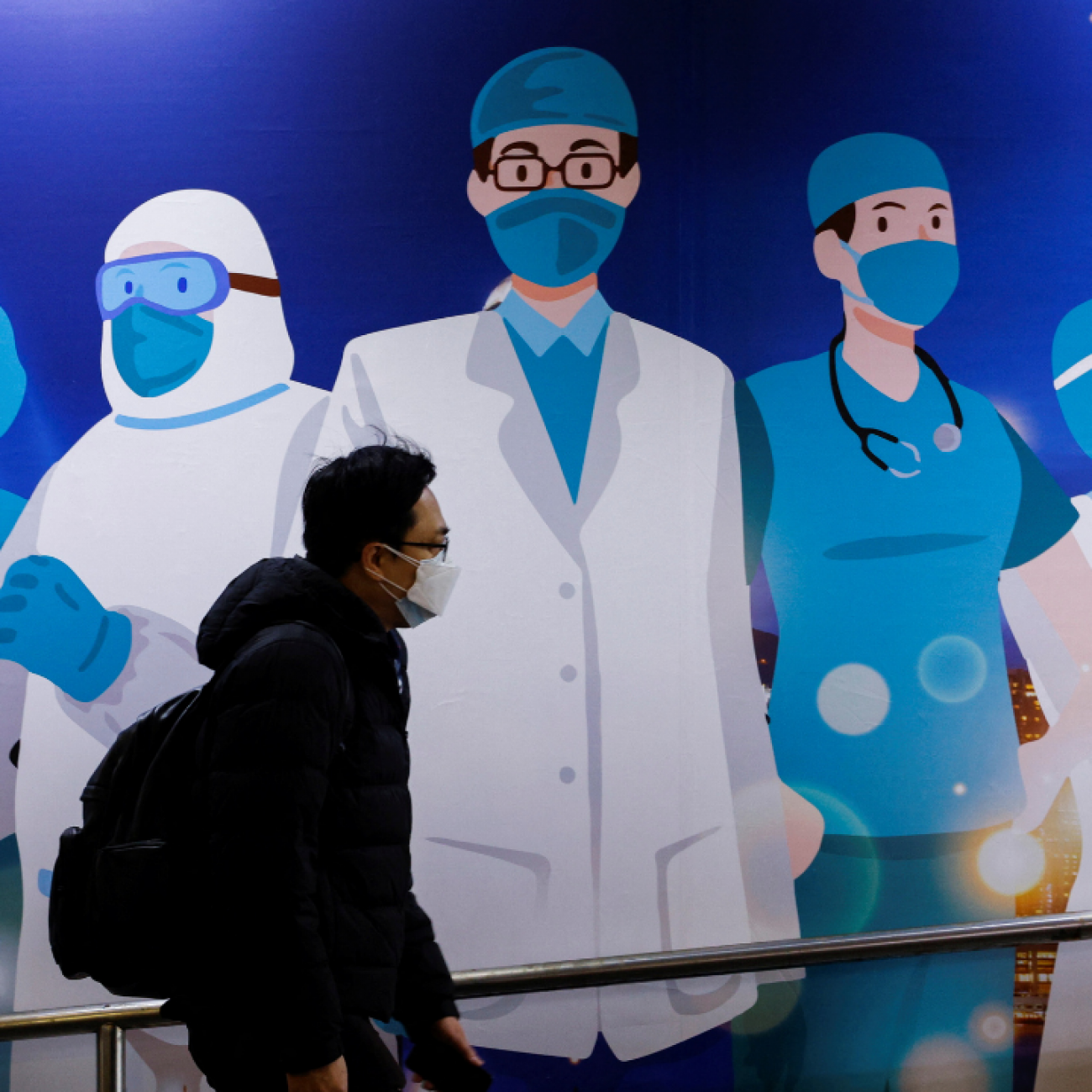More than two years into the COVID-19 pandemic, most countries in the world have the virus under control for the moment, with deaths declining steeply and intensive care units claiming far fewer COVID patients. China is the exception. As transmission of the omicron variant speeds up in China, with the government imposing ever more aggressive lockdowns to halt its spread, the country is on the brink of a massive societal crisis.
Currently, mainland China is reporting fewer than five deaths per day. But daily deaths could potentially reach some of the most dramatic levels we've seen anywhere to date during the COVID-19 pandemic—more than three times as high as India's largest wave. A full-scale omicron outbreak in China could lead to more than 600,000 deaths in total by July.
Quick action and global solidarity are urgently needed to reduce this potentially staggering human suffering and loss of life. The world has the tools—mRNA vaccines, N95 masks, air ventilation/disinfection technologies, and antivirals—to prevent COVID from causing so many deaths in China. It is in the world's interest to help prevent an enormous surge of COVID and/or wide-ranging lockdowns across China which would lead to greater global economic turmoil and even social unrest, especially with inflation rising and food security threatened by the war in Ukraine.
A full-scale omicron outbreak in China could lead to more than 600,000 deaths in total by July 2022
It's still possible that China will succeed in stamping out this latest outbreak of omicron in Shanghai through lockdowns, as they did in Beijing earlier this year. But omicron's highly transmissible BA.2 mutation is a formidable enemy, and it could tear through communities like wildfire as it did recently in Hong Kong. As was the case in Hong Kong, most people in mainland China have never been infected by SARS-CoV-2, the virus that causes COVID-19. This, paradoxically, is due to China's "zero COVID" policy, which aims to keep virus transmission as close to zero as possible using a "find, test, trace, isolate and support" protocol.
Even heavily infected countries, including the United Kingdom, have struggled with omicron, however, experiencing spikes in cases, hospitalizations, and deaths. Earlier this year, the United Kingdom experienced another short COVID-19 wave due to the omicron followed by a second BA.2 variant wave in March and the removal of COVID restrictions, even though 97-99 percent of its adult population has COVID-19 antibodies. Given the high number of reinfections now in Europe, and countries' inability to avoid surges in hospitalization despite many past COVID waves, China's current policy of lockdowns is still the safest approach, especially when factoring in the potential impact of long COVID. Indeed, China is in a tough position as relaxation of mandates will overwhelm the medical system and cause large numbers of deaths. Yet, continued lockdowns and extensive testing will exhaust its health system and put further strains on China's economy, and in turn, possibly the global economy.
There is another layer of vulnerability for China—the weakness of the COVID-19 vaccines that China administered to its population. Its inactivated viral vaccine, Sinopharm, and the Chinese military's vector vaccine, CanSino, provide less protection against severe disease compared to mRNA vaccines such as the Pfizer-BioNTech vaccine and the Moderna vaccine. Most worrisome are the reports of low vaccination rates among adults in China who are over the age of 60, and who were excluded from the initial rounds of vaccine campaigns in the country due to concerns about vaccine safety. This initial messaging may be intractable, and may still be making older adults in the country wary of getting vaccinated. In addition, the booster rollout in China has lagged behind most European countries.
What Can China Do?
China needs to expand access to mRNA vaccines, particularly among older adults and those with underlying conditions who are immunocompromised. Urgently providing mRNA jabs to older adults in nursing homes could prevent a substantial number of deaths. China should secure as many mRNA vaccines as possible, especially from Western countries, where large stocks exist. Early on, China refused mRNA vaccines in favor of their home-grown vaccines. It is encouraging that the country has recently changed its policy and is now permitting the import of mRNA vaccines while developing its own version, Walvax. But unfortunately, China's new mRNA vaccines cannot arrive fast enough to mitigate the current COVID wave.
Around 80 percent of those infected with omicron variants remain asymptomatic
China should prepare hospitals for an impending surge in admissions, making expanding intensive care capacity a top priority. Mass polymerase chain reaction (PCR) testing and the quarantine of all who test positive drain health-care resources and may not be necessary given that around 80 percent of those infected with omicron variants remain asymptomatic. It's also vital to protect people from getting infected with COVID-19 at testing sites by requiring KN95 masks and social distancing.
Also, scaling up education efforts to alleviate public anxiety while simultaneously mandating the use of high-quality masks should be implemented now before the virulent omicron takes hold across the country. If 80 percent of people wore masks in China, it could save hundreds of thousands of lives by July 1, 2022.
Increasing the production of antivirals could help avoid a huge spike in cases, overwhelming hospitals, and many deaths. Pfizer has authorized intellectual property waivers for firms in China so they may produce a generic form of Paxlovid. By scaling up production rapidly, this antiviral therapy strategy may not only help China, but also other countries in the long term as the world is expected to continue battling this virus and its variants into the foreseeable future.
What Can the World Do to Help China?
Global solidarity is more important than ever right now. Countries should prioritize the production of antivirals and share them with China. The world should provide COVID-19 vaccines, supplies (ventilators, hazmat suits, gloves, disinfectant), medical staff, and even field hospitals to China if needed. Helping China contain the virus is a sure strategy to contain this global pandemic and to reduce further economic turmoil. Indeed, if China fails to contain this wave, the world could see an economic crisis that has a deep impact everywhere.
For countries with an unparalleled health-care workforce, such as the United States, it is time to deploy humanitarian assistance to help save lives in China. In doing so, the United States will also enhance its own future pandemic preparedness and biosecurity.
COVID-19 has caused extensive damage to lives and livelihoods in communities across the globe, but it should not cause us to forget our humanity. COVID-19 has shown us that viruses do not respect borders, and that global collaboration is vital to curb the spread of the disease. Scientific effort, technological breakthroughs, and global collaboration since the emergence of this new disease represent an unprecedented triumph of human ingenuity. All lives are equal. The pandemic's greatest lesson should be that we collectively rise as a planet and unite, working toward greater health and prosperity as one civilization.
ACKNOWLEDGEMENTS: The authors would like to thank Rebecca Sirull for fact-checking assistance.
EDITOR'S NOTE: Ali H. Mokdad is employed by the University of Washington's Institute for Health Metrics and Evaluation (IHME), which produced the COVID-19 forecasts described in this article. IHME collaborates with the Council on Foreign Relations on Think Global Health. All statements and views expressed in this article are solely those of the individual authors and are not necessarily shared by their institutions.




